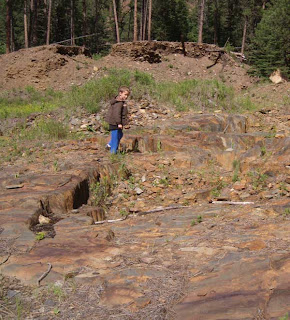 |
| Alex helps demonstrate the extend of a famous placer... bedrock cleaned back to still existing gravels. This is in a withdrawn area... note no shovels or pans, just a camera! |
Some things never change… other things change with each gust of wind.
This couldn’t be more apparent while reading a 1933 “Report of Investigations No. 15” SD State Gological Survey by E.P. Rothrock, state geologist. He says it all in a way I often strive to communicate, and fail!
“The number and wide range of old workings lead to the conclusion that few recognizable surface indications of metal-bearing deposits have been overlooked. However, there are still chances of success for those who, with assured resources, stamina and equipment will study the record of placer mining and choose favorable regions for their prospecting.
“The gold found in placers originally existed in place as deposits of various forms in areas intruded by igneous rocks. In some cases it was deposited in the igneous rock itself in finely disseminated particles; in other cases it was originally in quartz veins, cutting through the igneous and other rocks and formed as a result of the igneous intrusions. Due to disintegrating processes (change of temperature, wind, rain, earth movements and chemical action of running water, and of glaciers in some instances), the gold-bearing rock is transported away from its source. The moving water causes the heavier gold particles to work slowly toward the bottom of the stream bed. On reaching bedrock, or hard pan, the gold moves slowly downstream until it lodges in crevices, cracks or other irregular openings in the stream bed.”
Anyway, this is a reader-friendly report and email me if you want the entire report or just search for it on the net. What I want to relay to you is the following information on the different types of placers. I hope it will help explain why superficial panning from the creek is usually fruitless or bears little gold.
Residual placers: “These are placers in which the gold is accumulated in placers by disintegration of the rock containing it. It is not transported from its original source.”
Hillside placers: “These are very old deposits, occurring on the tops and sides of hills. They may have been left in this elevated position because of earth disturbances which lifted the area above the former stream, or the original stream which deposited them may have changed its course or have meandered to a new bed. These deposits are intermediate between the creek and bench placers. Their bedrock shows no indication of benching.”
Creek placers: “The creek placers are gravel deposits in the beds and intermediate flood plains of small streams. These placers from which most of the gold has been taken constitute the best-known type of deposit. Brooks described this form of placer as follows: ’The pay streak in these deposits is usually on bedrock though it sometimes is found on a clay which overrides the bedrock. Where no clay is present the gold is found not only on the bedrock, but also where the rock is broken, the gold has worked its way down into the joints and crevices. Streams are often found to have a layer of clay on bedrock, which gradually thins out upstream and finally disappears entirely. The presence of the clay on the bedrock usually indicates that no gold will be found in the weathered rock below, as the impervious layers prevent the gold from working its way down.’”
Gulch placers: “These are very similar to creek placers, except that there is now little, if any, flowing water present.”
Bench or terrace placers: “These are more or less ancient placers, occurring in bench or terrace form, on the sides of valleys or courses of ancient streams from 50 to 300 feet or more above the present stream level. The presence of well rounded gravel is indicative of material carried and sorted by water.
Change, as we mentioned before, has been in the legal system. When this report was written in 1933, there was no state regulation of South Dakota minerals. That’s a whole lot different these days!
We conclude this blog with an oft-repeated phrase of “practice, practice, practice!” We tell newbie-prospectors this about panning, prospecting… everything!
“Technical or scientific education, although it would be helpful, is not necessary for the prospector. However highly he is educated, he has to learn by experience. He cannot, by reading books, set forth into the mountains a full-fledged prospector. A prospector, however, must have ‘courage, natural resourcefulness, good powers of observation, but most of all, tireless patience and physical energy. A new mine is not likely to be found on a summer’s holiday or a casual vacation.”
While we’re on the subject of efficient prospecting, we researched for the heck of it the Sunset Valley Mining Co. claims called the Mystics. There exists, in this section, 40 acres of ground open for mineral entry. The rest is withdrawn or private. These 40 acres, as far as we can tell from record, have been staked since 2008. Sunset Valley staked probably 80+ acres in this area. That puts 40 acres over the top of another claimholder and 40+ in a withdrawn area! Kindof hard to win in a case like this! Bob says, “That’s a mighty expensive piece of paper!”
No comments:
Post a Comment